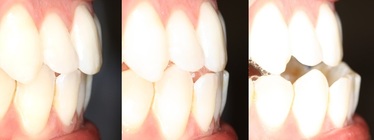 Advancing the mandible further does not necessarily lead to a lower AHI. Advancing the mandible further does not necessarily lead to a lower AHI. BY TATE H. JACKSON STUDY SYNOPSIS An Italian group has published a systematic review and meta-analysis that holds some practical clinical information for orthodontists or dentists using mandibular repositioning appliances to treat obstructive sleep apnea. The authors followed PRISMA guidelines and reviewed publications from 1990 – 2015. Only randomized controlled trials were included in the analysis of the association between reduction in apnea-hypopnea index (AHI) and therapy with a mandibular repositioning device in adults. Importantly, all changes in sleep-disordered breathing were measured by polysomnography (PSG) – both at baseline and after treatment. 13 studies were included in the analysis. Successful reduction in AHI (reduction of sleep apnea) was found in studies where the mandible was advanced as little as 25% of the maximum protrusion possible. Advancement of 50% showed equivalent results to advancements of a greater magnitude. Although the treatment modality was effective in significantly reducing AHI, no clear association between advancing the mandible further and a greater reduction in AHI could be made. Since variability in individual response was reported, the authors suggested a conservative and personalized approach to treatment by initially posturing the mandible forward only “the minimum effective” distance. WHAT THE PROFESSOR THINKS Although the authors conclude that the 13 RCT’s included in this meta-analysis represent a relatively small body of evidence of moderate quality, the data presented have some strengths. Only randomized controlled trials where the outcome of interest was clearly defined were included. The “gold standard” of polysomnography was used to assess changes in sleep apnea in each study. Further, only studies that accounted for changes in BMI and considered patients over 18 were included. From an orthodontic perspective, posturing the mandible forward in a non-growing adult with a fixed or removable appliance could certainly have ramifications, both for the patient’s occlusion / alignment and for the patient's comfort / ability to tolerate the appliance. If protruding the mandible 50% of the maximum possible works, then tooth-movement side effects, as well as pain and discomfort, might be limited. Not posturing the mandible forward fully at baseline might also allow for future increases over time as needed. This article provides two key pieces of information for the clinician treating sleep apnea in adults with appliances that protrude the mandible:
As the enthusiasm for treating sleep apnea with mandible-posturing oral devices continues, these data may become more and more relevant for orthodontists – either as we provide treatment for sleep apnea, or as we address the potential changes in occlusion and alignment caused by such treatment. Article Reviewed: Bartolucci, et. al. The effectiveness of different mandibular advancement amounts in OSA patients: a systematic review and meta-regression analysis. Sleep Breath. Jan 2016
0 Comments
Leave a Reply. |
Curated by:
Tate H. Jackson, DDS, MS CategoriesArchives
October 2019
|
Copyright © 2016
 RSS Feed
RSS Feed